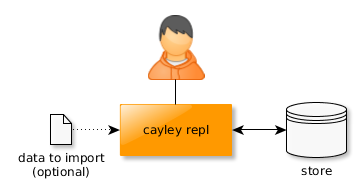The cayley repl command
#
The REPL is the acronym of Read-Eval-Print-Loop.
We can use the cayley repl command to open a console to an existing database, and interactively execute queries and other operations on the database.
The console works similar to a normal Linux console.
We can type in the expressions, then press the Enter, and the interpreter will execute, then prints the results.
It is also possible to use the up/down arrows to navigate among the previously entered commands.
The expressions we execute will be stored into a .cayley_history file, that we can open with a text editor, and extract the expressions we used previously.
This way the REPL is a very efficient tool to experiment with queries, then move the results of experiments to the final query files.

Figure 3.: cayley repl
The following session starts REPL on an existing database, then queries and prints all the nodes stored in the database:
$ cayley repl --db bolt --dbpath /home/tombenke/tmp/cayley/
I0915 18:02:08.623789 25897 cayley.go:63] Cayley version: 0.7.5 (cf576babb7db)
I0915 18:02:08.623971 25897 database.go:187] using backend "bolt" (/home/tombenke/tmp/cayley/)
cayley> g.V().All()
****
id : <bob>
****
id : <status>
****
id : cool_person
****
id : <alice>
****
id : <greg>
****
id : <emily>
****
id : <smart_graph>
****
id : <predicates>
****
id : <dani>
****
id : <fred>
****
id : smart_person
****
id : <charlie>
****
id : <are>
****
id : <follows>
-----------
14 Results
Elapsed time: 3.046727 ms
cayley>
Let’s see the content of the .cayley_history file after the session:
$ cat .cayley_history
g.V().All()
The Discover and unknown graph section demonstrates how can we use the cayley repl command to discover a graph we know nothing about.